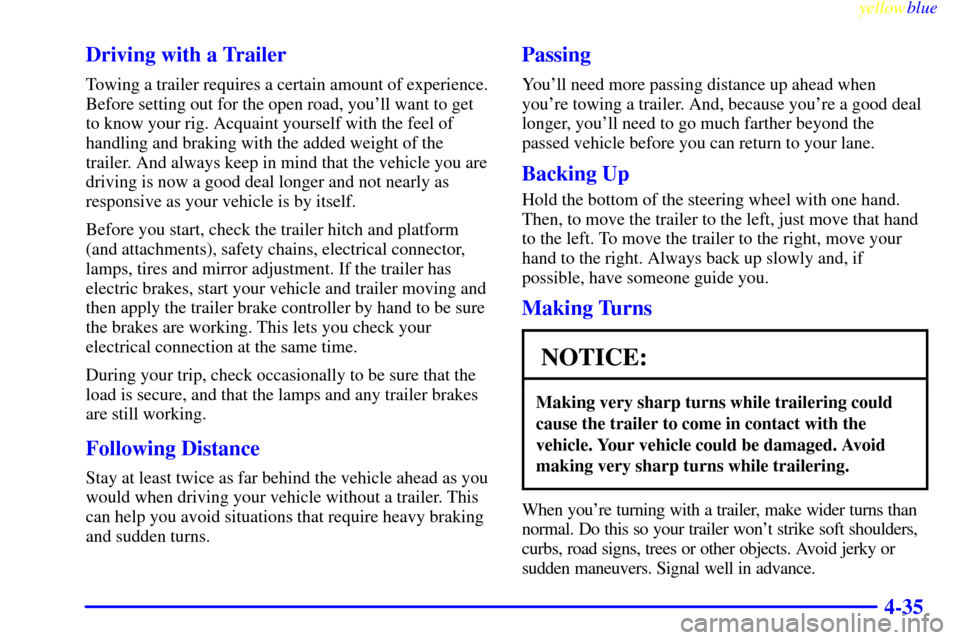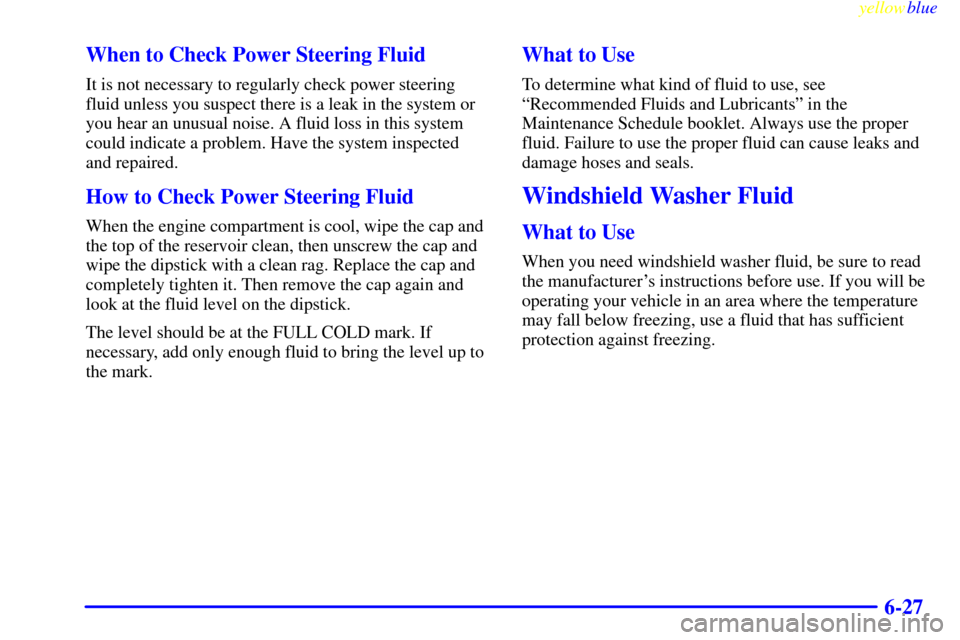Page 211 of 344

yellowblue
4-35 Driving with a Trailer
Towing a trailer requires a certain amount of experience.
Before setting out for the open road, you'll want to get
to know your rig. Acquaint yourself with the feel of
handling and braking with the added weight of the
trailer. And always keep in mind that the vehicle you are
driving is now a good deal longer and not nearly as
responsive as your vehicle is by itself.
Before you start, check the trailer hitch and platform
(and attachments), safety chains, electrical connector,
lamps, tires and mirror adjustment. If the trailer has
electric brakes, start your vehicle and trailer moving and
then apply the trailer brake controller by hand to be sure
the brakes are working. This lets you check your
electrical connection at the same time.
During your trip, check occasionally to be sure that the
load is secure, and that the lamps and any trailer brakes
are still working.
Following Distance
Stay at least twice as far behind the vehicle ahead as you
would when driving your vehicle without a trailer. This
can help you avoid situations that require heavy braking
and sudden turns.
Passing
You'll need more passing distance up ahead when
you're towing a trailer. And, because you're a good deal
longer, you'll need to go much farther beyond the
passed vehicle before you can return to your lane.
Backing Up
Hold the bottom of the steering wheel with one hand.
Then, to move the trailer to the left, just move that hand
to the left. To move the trailer to the right, move your
hand to the right. Always back up slowly and, if
possible, have someone guide you.
Making Turns
NOTICE:
Making very sharp turns while trailering could
cause the trailer to come in contact with the
vehicle. Your vehicle could be damaged. Avoid
making very sharp turns while trailering.
When you're turning with a trailer, make wider turns than
normal. Do this so your trailer won't strike soft shoulders,
curbs, road signs, trees or other objects. Avoid jerky or
sudden maneuvers. Signal well in advance.
Page 233 of 344

yellowblue
5-19
5. Then replace the pressure cap. Be sure the arrows on
the pressure cap line up like this.
Start the engine and allow it to warm up. If the CHECK
COOLANT LEVEL message does not appear on the
Driver Information Center, coolant is at the proper fill
level. If a CHECK COOLANT LEVEL message does
appear, repeat Steps 1 to 3 and reinstall the pressure cap
or see your dealer.
If a Tire Goes Flat
It's unusual for a tire to ªblow outº while you're driving,
especially if you maintain your tires properly. If air goes
out of a tire, it's much more likely to leak out slowly.
But if you should ever have a ªblowout,º here are a few
tips about what to expect and what to do:
If a front tire fails, the flat tire will create a drag that
pulls the vehicle toward that side. Take your foot off the
accelerator pedal and grip the steering wheel firmly.
Steer to maintain lane position, and then gently brake to
a stop well out of the traffic lane.
A rear blowout, particularly on a curve, acts much like a
skid and may require the same correction you'd use in a
skid. In any rear blowout, remove your foot from the
accelerator pedal. Get the vehicle under control by
steering the way you want the vehicle to go. It may be
very bumpy and noisy, but you can still steer. Gently
brake to a stop
-- well off the road if possible.
If a tire goes flat, the next part shows how to use your
jacking equipment to change a flat tire safely.
Page 246 of 344

yellowblue
5-32
If You're Stuck: In Sand, Mud,
Ice or Snow
In order to free your vehicle when it is stuck, you will
need to spin the wheels, but you don't want to spin your
wheels too fast. The method known as ªrockingº can
help you get out when you're stuck, but you must
use caution.
CAUTION:
If you let your tires spin at high speed, they can
explode, and you or others could be injured.
And, the transaxle or other parts of the vehicle
can overheat. That could cause an engine
compartment fire or other damage. When you're
stuck, spin the wheels as little as possible. Don't
spin the wheels above 35 mph (55 km/h) as shown
on the speedometer.
NOTICE:
Spinning your wheels can destroy parts of your
vehicle as well as the tires. If you spin the wheels
too fast while shifting your transaxle back and
forth, you can destroy your transaxle.
For information about using tire chains on your vehicle,
see ªTire Chainsº in the Index.
Rocking Your Vehicle To Get It Out
First, turn your steering wheel left and right. That will
clear the area around your front wheels. You should turn
your traction control system off. (See ªTraction Control
Systemº in the Index.) Then shift back and forth
between REVERSE (R) and a forward gear, spinning the
wheels as little as possible. Release the accelerator pedal
while you shift, and press lightly on the accelerator
pedal when the transaxle is in gear. By slowly spinning
your wheels in the forward and reverse directions, you
will cause a rocking motion that may free your vehicle.
If that doesn't get you out after a few tries, you may
need to be towed out. If you do need to be towed out,
see ªTowing Your Vehicleº in the Index.
Page 256 of 344
yellowblue
6-10
When you open the hood, you'll see:
A. Battery
B. Engine Coolant Fill Location
C. Power Steering FluidD. Engine Oil Fill Location
E. Engine Oil Dipstick
F. Brake Master CylinderG. Transaxle Dipstick/Fluid
Fill Location
H. Engine Air Cleaner/Filter
I. Windshield Washer Fluid
Before closing the hood, be sure all filler caps are on properly. Then pull the hood down and close it firmly.
Page 272 of 344
yellowblue
6-26
Adding Coolant
If you need more coolant, add the proper DEX
-COOL�
coolant mixture at the surge tank, but only when the
engine is cool.
CAUTION:
You can be burned if you spill coolant on hot
engine parts. Coolant contains ethylene glycol,
and it will burn if the engine parts are hot
enough. Don't spill coolant on a hot engine.
When replacing the pressure cap, make sure it
is hand
-tight.
Power Steering Fluid
The power steering fluid
reservoir is located next to
the coolant surge tank on
the passenger's side of
the engine.
Page 273 of 344

yellowblue
6-27 When to Check Power Steering Fluid
It is not necessary to regularly check power steering
fluid unless you suspect there is a leak in the system or
you hear an unusual noise. A fluid loss in this system
could indicate a problem. Have the system inspected
and repaired.
How to Check Power Steering Fluid
When the engine compartment is cool, wipe the cap and
the top of the reservoir clean, then unscrew the cap and
wipe the dipstick with a clean rag. Replace the cap and
completely tighten it. Then remove the cap again and
look at the fluid level on the dipstick.
The level should be at the FULL COLD mark. If
necessary, add only enough fluid to bring the level up to
the mark.
What to Use
To determine what kind of fluid to use, see
ªRecommended Fluids and Lubricantsº in the
Maintenance Schedule booklet. Always use the proper
fluid. Failure to use the proper fluid can cause leaks and
damage hoses and seals.
Windshield Washer Fluid
What to Use
When you need windshield washer fluid, be sure to read
the manufacturer's instructions before use. If you will be
operating your vehicle in an area where the temperature
may fall below freezing, use a fluid that has sufficient
protection against freezing.
Page 304 of 344
yellowblue
6-58
MaxiFuse
(6
-Way)Usage
BATT 3 Steering Column Ignition Switch
BATT 2 Steering Column Ignition Switch
IGN 1 Front Ignition
-1 Relay, Oxygen
Sensor 1 and 2 Fuse, Fuel Fuse,
Cruise Fuse, Fuel Pump Relay
BATT 1 Starter Relay and Solenoid,
Park/Reverse Fuse, Park Relay,
Powertrain Control Module (PCM)
Fuse, AC Compressor Fuse and Relay,
Fan Relays, Reverse Relay
BRAKES Anti
-Lock Brake System (ABS)
Brake Modulator
COOL FNS Cooling Fan Relays 1 and 3Power
Distribution
BlockUsage
ACCESSORY Accessories
HEAD LPS Headlamps
HORN Horn
FOG LPS Fog Lamps
DRL Daytime Running Lamps (DRL)
HI/LO BEAM High and Low
-Beam Headlamps
Relays
INADVERT POWER RELAY
IGN 1 RELAY
STARTER RELAY
Page 307 of 344

yellowblue
6-61
Fuse Usage
STOP Stoplamp Switch, Centered
High
-Mounted Stoplamp (CHMSL),
Turn Hazard Switch, ABS
Controller, Stepper Motor Cruise
Control, Right and Left Rear
Stoplamps (Export)
MIRROR Inadvertent Power Relay, Left
Outside Rearview Mirror Switch,
ALDL, Memory Mirror Module,
Dimmer Switch, Cluster
DRL Daytime Running Lamp (DRL)
Relay, Left and Right Low Beam in
DRL Mode, DRL Switch
IGN 0 (ENG) Powertrain Control Module (PCM)
SPARE Not Used
ABS Anti
-Lock Brake System
(ABS)/Traction Control System
IGN
-1 Rear Ignition-1 Relay, Front Fog
Lamp Relay, Rear Fog Lamp Relay
(Export), Controlled Power Backup
Relay, DRL RelayFuse Usage
WIPERS Accessory Relay, Wiper Switch
A/C COMP AC Compressor Relay, Cooling
Fan Relays 1, 2, 3,
Compressor Clutch
PCM (BAT) PCM
PARK/REV Reverse Relay, Right and Left
Back
-Up Lamps, Electrochromic
Mirror (in Header), Park Relay,
Brake Transaxle
-Shift Interlock
(BTSI) Switch, Passenger Zone
Module (PZM)
ECS Transaxle Shift Solenoids, Mass
Airflow, Canister Purge, PCM,
Linear Exhaust Gas Recirculation
(EGR), Front Ignition
-1 Relay
PCM (IGN) Powertrain Control Module (PCM)
DIS Electronic Ignition Control Module
CRUISE Stepper Motor Cruise Control,
Power Steering Pressure Switch,
Low Refrigerant Pressure Cutoff
Switch, Park Relay